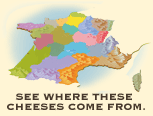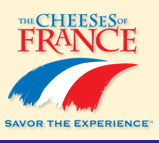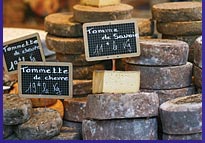A Cheese Plate
for the Full Terroir Experience
This extravagant cheese board is the ultimate Cheeses of France experience. With 15 classic French cheeses, each a product of unique regional terroir, it’s a fabulous tasting experience on a grand scale. Assemble all 15 cheeses for the full terroir experience, or choose one region and create your own regional Fromage Plate. The cheeses on this particular board are arranged as they might appear on a map of France. For example, the Camembert is positioned at the Northwest Normandy corner of the board; the Fleur du Maquis is at the Southeast Corsica corner; and the Beaufort is at the Eastern French Alps side of the board.
Max’s recommended tasting order: Tradition Jacquin, Fleur du Maquis, Crottin Aged, Saint-Marcellin , Ossau-Iraty, Brie, Camembert, Mimolette, Fleur des Alpes, Munster, Epoisses, Cantal, Comté, Beaufort, Roquefort.
The Cheeses
Fleur du Maquis — Corsica. An artisanal ewe’s milk cheese from the island of Corsica, whose name translates as “flower of the maquis,” the French term for the scrubby local terrain. Soft, mild and aromatic, sometimes with a dusting of bluish mold that is encrusted with rosemary or savory.
If you can’t find it, ask for: An herb-encrusted fresh cheese from Corsica or Provence.
Saint-Marcellin — Rhône-Alpes. A legendary farmhouse cheese made from the milk of cows that graze in the mountainous Dauphiné Province in southeastern France. Small rounds with natural rinds that turn from white to light brown as they age. Inside, the pâte is softer and mild, but rich.
If you can’t find it, ask for: Saint-Félicien.
Fleur des Alpes — A new cheese made from the milk of select farms in the Savoie. A special blend of cultures imparts a nutty, buttery flavor and soft, delicate texture to the cheese, which has a mild and mushroomy flavor and luscious pâte.
If you can’t find it, ask for: A cheese with a washed rind and creamy pâte.
Munster (AOC) — Alsace. An ancient washed-rind cheese that traces its roots back to monastic life in the Middle Ages. Munster is made from the milk of cows that graze in the mountains of Vosges region in Alsace, northeastern France. Its bright pinkish-orange rind turns darker and more red with age.
If you can’t find it, ask for: Tomme d’Alsace, or another recommended washed rind cheese from Alsace.
Mimolette — Nord-Pas de Calais. Produced in Flanders in the northernmost region of France, this pasteurized cow’s milk cheese is pressed, cooked and shaped like a cannonball. Mimolette hardens as it ages, its interior turning a deeper orange and acquiring a mouthwatering array of fruity, nutty flavors. Best when aged 18 months or more.
If you can’t find it, ask for: Aged Comté
“Lip-smacking, jaw-clacking flavor! Mimolette is an easy, graceful cheese with no rough edges. It’s great for snacking and looks beautiful on the plate.” Max McCallman, Maître Fromager
Epoisses (AOC) — Burgundy. This cow’s milk, washed-rind cheese comes from Burgundy. Strong-smelling, with a soft, smooth and mouth-watering flavor, it is washed with wine or usually with marc spirits, which give it a distinctive aroma. The rind has an orange tinge that darkens with age.
If you can’t find it, ask for: Munster, Affidelice, Perriere, Soumaintrain or Trou du Cru.
Camembert — Normandy. Camembert is a world-renowned cow’s milk cheese from the Normandy region in northwestern France. This quintessential French cheese has a soft, white, bloomy rind; luxurious ivory pâte; and buttery, grassy flavor. The taste of a ripe Camembert is reminiscent of wild mushrooms.
If you can’t find it, ask for: Pont-l’Evêque or Pavé d’Auge.
Ossau-Iraty (AOC) — Pyrénées. A classic sheep’s milk cheese made with the milk of the Manech and Basco-Bearnaise ewes. Aged for at least 90 days, the shape of each wheel can vary from region to region, with an ivory pâte, an aroma of toasted hazelnuts and a sweet, buttery flavor.
If you can’t find it, ask for: Abbaye de Belloc, P'tit Basque, Kaikou, Chistou, P'tit Pyrénées, Ardi-Gasna or another recommended sheep milk cheese that is made in the French Pyrénées.
Roquefort (AOC) — Southern France. Famous through the ages, this blue cheese is made from ewe’s milk in southern France. AOC rules dictate that the cheese must be ripened in the caves of Cambalou for 3 to 9 months. Known for its rich, mild creaminess and soft, spicy, tart flavors.
If you can’t find it, ask for: Bleu des Causses, Bleu des Basques, Fourme d'Ambert. A good quality Roquefort will make a lasting impression. A milder choice would be Bleu d’Auvergne.
Crottin aged-Loire. This goat’s milk cheese is made in the heart of France in the verdant Loire Valley. When the Crottin is young, it is moist and has a gentle tangy goat’s milk flavor. As it ages, this lovely little cheese takes on a firmer texture and a stronger, gamier flavor, and is equally delicious.
If you can’t find it, ask for: Any aged or firmer-textured chèvre from the Loire Valley. Try Chabichou du Poitou, Crottin de Champcol or try a younger Crottin!
Brie de Nangis — Ile-de-France. Produced just southwest of Paris, this is one of the milder, more buttery Bries. It almost disappeared from production but has seen a revival over the past few decades. Brie de Nangis is creamy and smooth and has a slightly chalky center that becomes runny with age.
If you can’t find it, ask for: A good quality Brie or Coulommiers.
“Nice, fun and gooey. There’s a debate: some say eat the rind, personally, I never do.”
Max McCalman, Maître Fromager
Tradition Jacquin — Loire. The quintessential goat’s milk cheese, produced from goats that graze in the fields around the Loire River in central France. The light dusting of ash on these small discs attracts beneficial mold, protecting the subtle, gentle interior of the cheese. The taste is mild, milky and creamy with hints of citrus.
If you can’t find it, ask for: Sainte Maure.
Cantal (AOC) — Auvergne. A distinguished, semi-hard cheese from the central mountainous region of Auvergne, Cantal is a cheddar-like cow’s milk cheese cured with salt, which brings out its full flavor. Heavy and moist, young Cantal has a sweet, milk flavor; well-aged, it has a sharper flavor.
If you can’t find it, ask for: Laguiole or Salers are both cheddar-like cow’s milk cheeses from the same region.
Comté (AOC) — Franche-Comté. One of the most popular cheeses in France, Comté is produced in the rich mountain pastures of the Jura. Its firm and supple pâte, with very small holes, or “eyes,” has a nutty, slightly salty yet sweet taste. Comté is produced year-round by small, cooperative dairies known as fruitières.
If you can’t find it, ask for: French Gruyère, Beaufort.
Beaufort (AOC). Famous since Roman times, Beaufort is one of the noble cheeses of the French Alps. Made from the milk of an ancient mountain breed of mahogany-colored cows, Beaufort is distinguished by its concave-shaped rind. It has a dense, concentrated, buttery consistency, a fruity aroma and rich, nutty flavors with a hint of sweetness.
If you can’t find it, ask for: Comté or French Gruyère.
“This is a show stopping cheese! As legend has it, Beaufort was created with its concave rinds so that it would fit safely at the sides of a donkey as it traveled over the mountain passes. This cheese kept well over the winter months, providing good nutrition during times of scarcity.”
Max McCalman, Maître de Fromager
All soft-ripened cheeses used in our Signature Fromage Plates are made from pasteurized milk, and therefore comply with FDA regulations.








